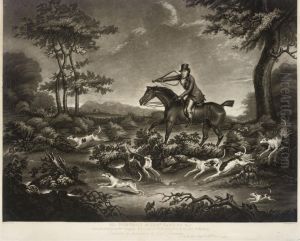William Dunkarton Paintings
William Dunkarton was a British engraver and printmaker known for his works during the late 18th and early 19th centuries. Born in 1745, Dunkarton was a figure of some prominence in the London art scene, particularly recognized for his skill in mezzotint, a printmaking process that allows for the creation of images with a wide range of tonal variation.
Dunkarton's career flourished during a period when there was significant demand for engravings and mezzotint prints, which were sought after by collectors and the general public who desired copies of the works of well-known painters. He was contemporary with other notable artists and engravers of the time, such as Joshua Reynolds and William Hogarth, and was part of a thriving artistic ecosystem that included painters, printmakers, publishers, and patrons.
Not much is recorded about Dunkarton's personal life, and he seems to have been someone whose public identity was largely tied to his professional output. His works include portraits, which were popular at the time, and he often collaborated with painters, translating their painted portraits into prints. Dunkarton's engravings exhibit a high level of craftsmanship and an ability to capture the subtle gradations of light and shadow that characterize mezzotint prints.
Dunkarton passed away in 1815, leaving behind a body of work that has contributed to the historical understanding of printmaking in Britain during his era. His prints continue to be of interest to collectors and historians, as they represent not only artistic skill but also social and cultural trends of the Georgian period.
